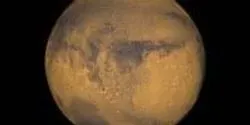Mars

New research at the University of Arkansas suggests that methanogens – among the simplest and oldest organisms on Earth – could survive on Mars.

Data collected on Mars by NASA’s Curiosity rover and analyzed by University of Arkansas researchers indicate that water, in the form of brine, may exist under certain conditions on the planet’s surface.

Observations by NASA's Curiosity Rover indicate Mars' Mount Sharp was built by sediments deposited in a large lake bed over tens of millions of years.

These two infrared images of C/2013 (Comet Siding Spring) were taken by the Compact Reconnaissance Imaging Spectrometer for Mars (CRISM) aboard NASA’s Mars Reconnaissance Orbiter (MRO) on Oct. 19, 2014. Comet Siding Spring — an Oort Cloud comet that may contain material from the formation of the solar system some 4.6 billion years ago — was making its first voyage through the inner solar system. CRISM and many other instruments and spacecraft combined to provide an unprecedented data set for an Oort Cloud comet.

In chambers that mimic Mars' conditions, University of Michigan researchers have shown how small amounts of liquid water could form on the planet despite its below-freezing temperatures.













